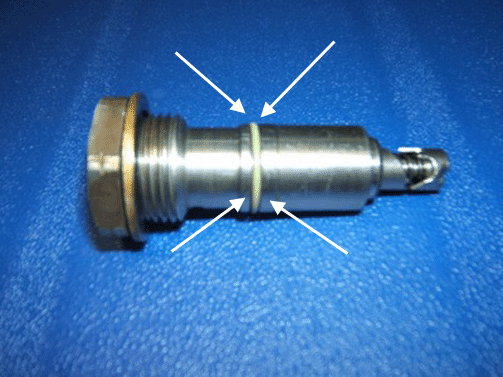
| Subject: | Parts Update - Timing Chain Tensioner Design Change |
| Models: | 2002-2005 Chevrolet Cavalier |
| 2005-2007 Chevrolet Cobalt, Cobalt SS |
| 2004-2007 Chevrolet Malibu |
| 2004-2005 Chevrolet Malibu Classic |
| 2002-2004 Oldsmobile Alero |
| 2002-2005 Pontiac Grand Am, Sunfire |
| 2005-2006 Pontiac Pursuit (Canada Only) |
| 2006-2007 Pontiac Solstice |
| 2004-2007 Saturn Ion Redline |
| 2001-2005 Saturn L Series |
| with any of the following engines: |
| 2.0L Engine (VIN P - RPO LSJ) |
| 2.2L Engine (VIN D or F - RPO L61) |
The following diagnosis might be helpful if the vehicle exhibits the symptom(s) described in this PI.
Condition/Concern:
When replacing the timing chain tensioner, some technicians may notice that the replacement timing chain tensioner does not contain an O-ring like the original timing chain tensioner that they removed from the vehicle (original design shown below). As
a result, some technicians may believe that they received the incorrect timing chain tensioner from their parts department.

Recommendation/Instructions:
Due to a design change and related part number supersession that took place during August 2004, the replacement timing chain tensioner from SPO no longer contain an O-ring as shown above. Instead, the tensioner body of the replacement timing chain tensioner
is about .480" (12.192 mm) thicker than the original tensioner design. This causes the timing chain tensioner to fit tighter into the cylinder head, allowing it to operate without an O-ring like the original one. As a result, the new design timing chain tensioner
(no O-ring) can be used in place of the original design timing chain tensioner (with O-ring).
Please follow this diagnostic or repair process thoroughly and complete each step. If the condition exhibited is resolved without completing every step, the remaining steps do not need to be performed.


